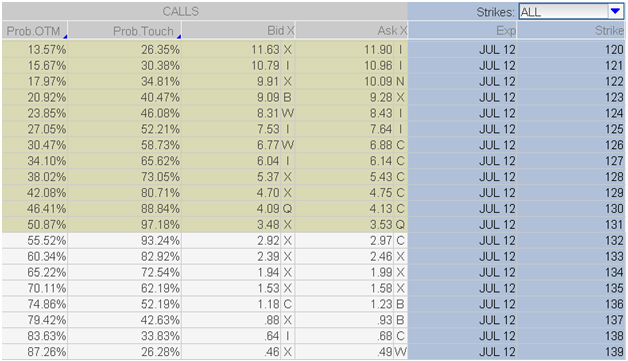I have received numerous questions on the probabilties of success. What is means, how it works. Hopefully the following post answers a few of those pending questions.
Once you have found a highly-liquid ETF in an extreme overbought/oversold state you can begin to look for a high-probability trade.
But before I get into the heavy stuff let me start out with some obligatory technical mumbo jumbo and then I will get to an example that should hopefully help to clear things up.
Probability of expiring: The ‘probability of expiring’ reflects whether an underlying stock’s price is above or below a strike price at expiration.
An underlying stock will either finish out-of-the-money or in-the-money so there are two possible scenarios for ‘probability of expiring’: probability of expiring in-the-money or probability of expiring out-of-the-money (Prob.OTM).
Remember, we want to keep it simple so let’s focus on what matters – probability of expiring out-of-the-money.
Probability of expiring out-of-the-money is the chance that a strike price will close at expiration below an underlying stock price for calls and above an underlying stock price for puts.
My trading software (Thinkorswim) offers this helpful tool, but for those of you who do not have a platform that offers Prob.ITM you can just use delta of an option as it is roughly the same percentage.
I will explain in a moment why it is so valuable to know the Prob.OTM.
Again, before I get to the nitty gritty, let me explain ‘probability of touching’ (Prob.Touch).
Probability of touching: considers the possibility of the stock hitting (touching) the strike price at any time between now and expiration.
Again, I realize that some of you do not have access to trading software that gives you the probability of touching either, but any worthy trading software will provide you with the delta of any given option. And the Prob.Touch is simply double the delta.
So, the real question is, how can we use Prob.OTM and Prob.Touch to our advantage?
Look at the chart below.
At the time I wrote up this example the price of SPDR S&P 500 ETF (SPY) was trading at $131.50 and in an overbought state. My assumption based on the current overbought state of SPY was the S&P 500 would move lower over the next 39 days (July expiration).
This is where it gets interesting.
Because I thought SPY would close below its price of $131.50 I wanted to choose a strike that had a Prob.OTM that is AT LEAST above 50% and in almost all cases higher. I prefer 85%.
Look at the strikes below for SPY call options in July to see what qualifies – 132 and above. The strike immediately above the price $131.50 of SPY, 132, has a Prob.OTM of 50.87%.

That’s not high enough for me. It is essentially a coin flip. Again, I prefer something that has a higher Prob.OTM – say the Jul12 139 strike, for instance. It has a Prob.OTM of 87.26%.
That means that that if I sell a call vertical, otherwise known as a bear call spread, I might sell the 139 call strike and buy maybe the 141 strike. The trade would have a probability of success (also known as the Prob.OTM) of 87.27%. Extrapolate the 87% out 100 trades or 1000 trades and you begin to see the value of using options strategies with a high Prob.OTM.
But what about Prob.Touch? How does that factor into all of this probability madness. Prob. Touch should be viewed as the potential stress level of a particular trade.
In our case, if we sold the SPY Jul12 139/141 call spread, the underlying ETF or SPY would have a 26.28% chance of touching our short strike of 139. I like that percentage because there is still a low probability that SPY will ‘touch’ my short strike. This is invaluable information because it gives you a good idea of how stressful the trade will be.
Just think if we decided to choose to short a strike with a lower Prob.OTM, which inherently has a higher Prob.Touch, at say the 135. Again, we want to use a bear call spread so we would sell the 135/137. The 135 has a Prob.OTM or probability of success of over 70%, which is still fairly high, considering a stock trade only has a 50% chance of success.
But if you notice the Prob.Touch you will discover that the probability is over 62%. That just means that while you still have a good chance of the trade going in your favor, you should expect to experience some stress with the trade.
Most newbie traders don’t think about this important aspect. Always remember – you want to take emotions out of the equation. One way to do this is position-sizing, which should ALWAYS be considered with each and every trade. But the other way is to keep your Prob.Touch below 50% preferably below 30%.
I know this is a lot to grasp, but again these are the strategies that are revolutionizing how self-directed investors (like you and me) think about investing. The movement has already begun – so don’t be left behind.
 Facebook
Facebook
 Twitter
Twitter